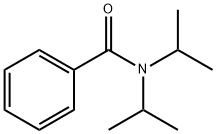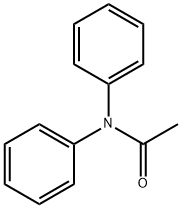N,N-Diethyl-m-toluamide
Synonym(s):m-Toluic acid diethylamide;N,N-Diethyl-m-toluamide;N,N-Diethyl-3-methylbenzamide;DEET
- CAS NO.:134-62-3
- Empirical Formula: C12H17NO
- Molecular Weight: 191.27
- MDL number: MFCD00009046
- EINECS: 205-149-7
- SAFETY DATA SHEET (SDS)
- Update Date: 2025-12-17 09:50:35

What is N,N-Diethyl-m-toluamide?
Absorption
Most diethyltoluamide (DEET) formulations employ the agent as a liquid to be applied onto human skin in an effort to repel mosquitoes from feeding on the skin. Topical application and absorption is consequently the most common route of absorption. When used appropriately, DEET formulations are generally not indicated for too many other routes of absorption or administration, like parenterally or orally.
Toxicity
Ingestion of diethyltoluamide (DEET) in adults may lead to hypotension, seizures, and/or coma within as little as an hour . Deaths have been associated with serum concentrations of 1 mmol/L . Psychosis was described in an adult who had applied a product containing 70% DEET to the skin .
Description
N,N-Diethyl-m-toluamide, known familiarly as DEET, has been the most widely used active ingredient in insect repellents since 1957. The compound was mentioned in the literature under the name “Autan” in connection with disinfection processes as early as 1907, but its first reported synthesis was in 1929 by N. N. Maxim in a Romanian journal.
DEET has been used effectively and, for the most part, safely for more than 60 years. But, as the hazard information table shows, it can cause some skin problems and has environmental concerns. Only rare cases of DEET toxicity or severe skin reactions have been reported.
Background
Diethyltoluamide (DEET) is the common active ingredient in many insect repellent products. It is widely used to repel biting pests such as mosquitoes and ticks. Every year, DEET formulations are used to protect populations from mosquito-borne illnesses like West Nile Virus, the Zika virus, malaria, and/or tick-borne illnesses like Lyme disease and Rocky Mountain spotted fever. And, despite concerns over excessive exposure to the chemical, appropriate usage of the chemical at the recommended dosages and routes of administration have generally proven to be safe - even when most DEET products are largely designed to be applied directly to human skin, where the exact mechanisms of actions in which DEET is capable of repelling insects and causing toxicity to humans is still not fully elucidated.
Indications
Diethyltoluamide, or DEET, is an active ingredient that is predominantly indicated for as an insect repellant used to repel biting pests like mosquitoes and ticks . Products containing DEET currently are available to the public in a variety of liquids, lotions, sprays, and impregnated materials like towelettes or roll-ons .
Pharmacokinetics
When used appropriately, diethyltoluamide (DEET) containing products are designed to be applied directly to people's skin as a means to elicit a repelling action to keep insects from targeting human skin . At the amounts and doses recommended for use on human children and adults, noticeable absorption or systemic exposure is not expected . Owing to the proportional difference in size between humans and insects, however, the exposure of insects to the applied DEET (whether topically or via inhalation of DEET) is expected to be enough to interfere with the insects' sensory attraction to human skin .
Metabolism
Diethyltoluamide (DEET) is metabolized in humans by cytochrome P450 enzymes into the primary metabolites N,N-diethyl-m-hydroxymethylbenzamide (BALC) and Nethyl-m-toluamide (ET) . Although several P450 isoenzymes have elicited activity in DEET metabolism, it appears that the CYP2B6 and CYP2C19 enzymes are the principal P450s responsible for the transformation of DEET to BALC and ET, respectively . Most of the body load is metabolized by such hepatic P450 enzymes, with only 10%–14% recovered unchanged in the urine .
Properties of N,N-Diethyl-m-toluamide
| Melting point: | -45 °C |
| Boiling point: | 111 °C1 mm Hg |
| Density | 0.998 g/mL at 20 °C(lit.) |
| vapor density | 6.7 (vs air) |
| vapor pressure | <0.01 mm Hg ( 25 °C) |
| refractive index | n |
| Flash point: | >230 °F |
| storage temp. | room temp |
| solubility | DMSO (Slightly), Ethyl Acetate (Slightly), Methanol (Slightly) |
| appearance | colorless to light yellow liquid |
| form | Liquid |
| pka | -1.37±0.70(Predicted) |
| Specific Gravity | 0.996 |
| color | Clear |
| Odor | mild bland odor |
| Water Solubility | NEGLIGIBLE |
| Merck | 14,2856 |
| BRN | 2046711 |
| Stability: | Stable. Combustible. Incompatible with strong oxidizing agents, strong acids, strong bases. Hydrolyzes slowly in water. |
| CAS DataBase Reference | 134-62-3(CAS DataBase Reference) |
| NIST Chemistry Reference | Diethyltoluamide(134-62-3) |
| EPA Substance Registry System | N,N-Diethyl-m-toluamide (134-62-3) |
Safety information for N,N-Diethyl-m-toluamide
| Signal word | Warning |
| Pictogram(s) |
 Exclamation Mark Irritant GHS07 |
| GHS Hazard Statements |
H302:Acute toxicity,oral H315:Skin corrosion/irritation H319:Serious eye damage/eye irritation H412:Hazardous to the aquatic environment, long-term hazard |
| Precautionary Statement Codes |
P264:Wash hands thoroughly after handling. P264:Wash skin thouroughly after handling. P270:Do not eat, drink or smoke when using this product. P273:Avoid release to the environment. P301+P312:IF SWALLOWED: call a POISON CENTER or doctor/physician IF you feel unwell. P302+P352:IF ON SKIN: wash with plenty of soap and water. P305+P351+P338:IF IN EYES: Rinse cautiously with water for several minutes. Remove contact lenses, if present and easy to do. Continuerinsing. |
Computed Descriptors for N,N-Diethyl-m-toluamide
| InChIKey | CXVBTGKUSLNJQZ-UHFFFAOYSA-N |
N,N-Diethyl-m-toluamide manufacturer
New Products
4,4-Difluoropiperidine hydrochloride tert-butyl 9-methoxy-3-azaspiro[5.5]undecane-3-carboxylate Indole Methyl Resin N-Isopropylurea N,N-Dicyclohexylcarbodiimide(DCC) MELDRUMS ACID 5-METHYLISOXAZOLE-4-CARBOXYLIC ACID Magnessium Bis glycinate Zinc ascorbate 1-bromo-2-butyne 2-acetamidophenol 9(10H)-anthracenone Erythrosin B, 4-Piperidinopiperidine 2-((4-morpholinophenylamino) (methylthio) methylene) malononitrile 2,4-dihydroxybenzaldehyde 3-(4-morpholinophenylamino)-5-amino-1H-pyrazole-4-carbonitrile Methyl 2-methylquinoline-6-carboxylate 2,6-dichloro-4-nitropyridine 4-Bromo-2-chlorobenzonitrile 2-(benzylamino)acetic acid hydrochloride 4-(tert-Butoxycarbonylamino)but- 2-ynoic acid 3,4-dihydro-2H-benzo[b][1,4]dioxepine 1-Phenyl-1-cycloprppanecarboxylicacidRelated products of tetrahydrofuran








You may like
-
 134-62-3 Diethyl toluamide 99%View Details
134-62-3 Diethyl toluamide 99%View Details
134-62-3 -
 DEET ( I.P ) grade * 99%View Details
DEET ( I.P ) grade * 99%View Details
134-62-3 -
 N,N-Diethyl-m-toluamide 99%View Details
N,N-Diethyl-m-toluamide 99%View Details -
 Diethyltoluamide 99.30%View Details
Diethyltoluamide 99.30%View Details
134-62-3 -
 N,N-Diethyl-m-toluamide CAS 134-62-3View Details
N,N-Diethyl-m-toluamide CAS 134-62-3View Details
134-62-3 -
 N,N-Diethyl-3-methylbenzamide 98.00% CAS 134-62-3View Details
N,N-Diethyl-3-methylbenzamide 98.00% CAS 134-62-3View Details
134-62-3 -
 Diethyltoluamide CAS 134-62-3View Details
Diethyltoluamide CAS 134-62-3View Details
134-62-3 -
 20677-73-0 (2,2-diethoxyethyl)methylamine 98%View Details
20677-73-0 (2,2-diethoxyethyl)methylamine 98%View Details
20677-73-0
